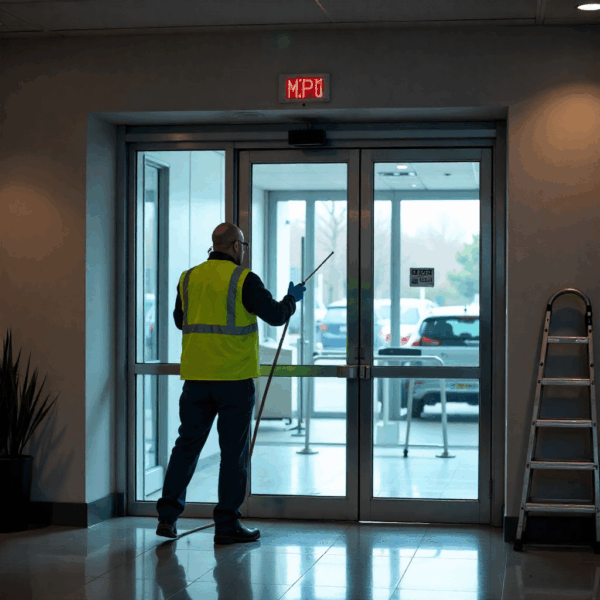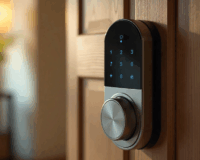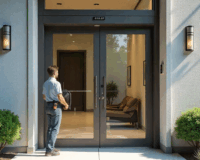The shopping centre environment has evolved dramatically over the past decade. From energy efficiency to customer convenience, every design element contributes to an inviting and efficient retail experience. Among these, door automation plays a surprisingly vital role in shaping traffic flow, safety, and accessibility.
A well-designed shopping centre automatic door doesn’t just open and close—it defines the first impression of a retail complex. It’s where architecture meets technology, offering seamless entry, optimized pedestrian flow, and compliance with accessibility standards.
This industry insight explores how shopping centres can leverage modern door automation technologies to improve visitor experience, energy management, and operational efficiency.
Understanding Door Automation in Retail Design
In the modern retail environment, door automation has evolved from a simple convenience into a critical design element that enhances both form and function. In a shopping centre, automatic doors serve as silent hosts—managing visitor entry, optimizing energy use, and ensuring accessibility for everyone. When designed well, they do more than open and close; they set the tone for the shopper’s entire experience. Understanding how these systems work, and how they can be integrated into architectural and operational planning, is fundamental for building owners and designers aiming to improve traffic efficiency and customer satisfaction.
Door automation refers to systems that enable doors to open and close automatically using sensors, access control, or push-button mechanisms. In shopping centres, this technology goes far beyond convenience—it’s part of an integrated system designed for:
-
Customer experience: Providing effortless access for shoppers of all ages and abilities.
-
Traffic optimization: Managing high-volume pedestrian movement during peak hours.
-
Energy efficiency: Minimizing air exchange and maintaining climate control.
-
Safety and hygiene: Reducing physical contact with handles or surfaces.
Automatic doors are available in various styles—sliding, swing, revolving, and telescopic systems—each designed to meet specific architectural and operational needs.

Types of Shopping Centre Automatic Doors
Every shopping centre presents a unique combination of architectural constraints, visitor volumes, and design aesthetics. The type of shopping centre automatic door selected must match these needs to ensure safety, flow, and efficiency. From sleek sliding doors that accommodate continuous crowds to elegant revolving doors that enhance insulation and luxury, choosing the right configuration determines both performance and presentation. In this section, we explore the key types of automatic doors commonly used in shopping centres and their ideal applications.
Sliding Automatic Doors
Sliding doors are the most common type in shopping centres. They provide wide openings for smooth crowd movement and are ideal for areas with continuous foot traffic.
Advantages:
-
Streamlined pedestrian flow
-
Space-efficient design
-
Energy-saving airlock options
Applications:
-
Main entrances
-
Supermarket access points
-
Transit link corridors
Swing Automatic Doors
These doors operate via motion sensors or push plates and are ideal for smaller entryways or service areas.
Advantages:
-
Easy retrofitting into existing structures
-
Cost-effective installation
-
Ideal for low to medium traffic areas
Applications:
-
Staff entrances
-
Maintenance zones
-
Internal retail doors
Revolving Automatic Doors
High-end shopping centres often choose revolving doors to combine luxury aesthetics with superior environmental control.
Advantages:
-
Excellent insulation and energy efficiency
-
Elegant architectural appeal
-
Reduced drafts and noise
Applications:
-
Main entrances of luxury malls or hotels
-
Mixed-use retail complexes
Telescopic Sliding Doors
Where space is limited but traffic flow is high, telescopic designs maximize opening width using overlapping door panels.
Advantages:
-
Optimized for narrow lobbies
-
Smooth and silent operation
-
Enhanced opening width
Applications:
-
Compact shopping centre entrances
-
Renovations with space constraints
The Importance of Design Flow in Door Automation
Design flow is one of the most overlooked aspects of door automation planning, yet it directly impacts how visitors move through a shopping centre. A well-planned layout minimizes congestion, improves accessibility, and ensures that automated doors operate at peak efficiency. When integrated strategically with entry points, corridors, and exit zones, automated doors can guide pedestrian flow naturally—improving the overall comfort and safety of the space. Understanding pedestrian behavior and designing door systems around it transforms a shopping centre from functional to fluid.
Pedestrian Traffic Patterns
Shopping centre entrances experience high variability in traffic—from weekday lulls to weekend surges. Automated doors must be positioned to complement these movement patterns.
Key considerations include:
-
Entry and exit segregation to prevent crowd congestion
-
Sensor placement for fast response during high traffic
-
Integration with smart analytics to measure flow and dwell time
A study by retail design firms shows that poorly positioned doors can reduce visitor throughput by up to 25%, directly affecting shopping experience and sales.
Accessibility and Inclusivity
Door automation supports inclusivity in compliance with Australian Standards. Every shopper—whether using a wheelchair, pushing a stroller, or carrying goods—should experience equal ease of movement.
Features such as low-energy swing operators, delayed closing times, and push-button accessibility ensure full compliance and customer comfort.
Aesthetic Integration with Architecture
Automatic doors should align with the overall design narrative of the shopping centre. Frameless glass doors, concealed tracks, and aluminum finishes can elevate the look while preserving structural harmony.
Architects often collaborate with door automation specialists early in the design phase to align performance with aesthetics—ensuring the system looks as good as it performs.
Smart Technology Integration
The latest trend in door automation is the integration of smart sensors and building management systems (BMS).
Features Include:
-
Adaptive motion detection: Adjusts door operation speed based on traffic flow.
-
Energy-saving modes: Automatically reduces standby power consumption.
-
Remote monitoring: Facility managers can check system health via mobile apps.
-
Access control compatibility: Integrates with RFID and keypad systems for staff-only zones.
For example, a shopping centre might use RFID-based control for loading docks while maintaining open-access automatic doors for customers. This multi-zone approach enhances both security and operational efficiency.
Energy Efficiency & Sustainability
Energy management is a key design objective for modern shopping centres. Doors are major contributors to HVAC loss if not properly automated.
Automatic doors help regulate energy consumption by:
-
Reducing uncontrolled air exchange between indoor and outdoor environments.
-
Integrating with air curtains and climate control systems.
-
Minimizing the need for constant manual operation.
According to the Australian Government’s Department of Climate Change, Energy, the Environment and Water, even small improvements in entryway insulation and air retention can lead to measurable energy savings across large facilities.

Safety and Compliance Standards
Safety remains paramount in any public infrastructure. Automatic doors must comply with Australian Standards to ensure safe operation.
Key safety requirements include:
-
Emergency stop functions
-
Obstruction detection sensors
-
Manual override options
-
Regular inspection and testing schedules
The Safe Work Australia guidelines also recommend that all automatic doors in high-traffic public areas undergo periodic safety assessments to prevent entrapment or malfunction.

Maintenance and Lifecycle Management
A shopping centre automatic door is a long-term investment. To ensure consistent performance, a proactive maintenance program is crucial.
Maintenance Tips:
-
Clean glass panels and motion sensors weekly.
-
Check drive units and belts for wear every quarter.
-
Calibrate sensors and timers annually.
-
Replace batteries in push-button systems on schedule.
Modern service contracts often include predictive maintenance alerts via IoT sensors—detecting component fatigue before failure occurs. This data-driven approach reduces downtime and extends the door’s lifespan.

Enhancing Customer Experience Through Automation
In retail environments, first impressions matter. Door automation contributes directly to how shoppers perceive convenience, safety, and quality. Smooth, quiet, and responsive automatic doors signal efficiency and professionalism from the very first step inside. They also promote inclusivity by accommodating all visitors — from parents with strollers to individuals with mobility aids. Beyond convenience, automated doors enhance hygiene and touchless entry, which have become crucial in the post-pandemic retail era.
Seamless Entry Experience
Customers subconsciously associate smooth door operation with a premium shopping experience. Lagging or noisy doors can diminish perceived brand value.
Improved Hygiene and Safety
Touchless access is increasingly important in the post-pandemic retail world. Infrared or motion-activated sensors eliminate surface contact, maintaining a healthier environment.
Accessibility for All Visitors
Inclusive design ensures compliance with the Disability Discrimination Act 1992 (Australia), while also making the shopping experience more enjoyable for everyone.
Integration with Emergency Systems
Automatic doors should interface with a shopping centre’s fire safety and emergency management systems. During emergencies, such as a fire or power failure, the doors must default to an open or safe mode to allow quick evacuation.
Smart automation controllers can link with building fire panels to ensure real-time safety compliance.

Cost Considerations and ROI
The initial investment for high-quality door automation can seem significant, but the long-term savings and customer satisfaction often outweigh the costs.
ROI Factors Include:
-
Reduced HVAC energy loss
-
Lower maintenance compared to manual systems
-
Enhanced tenant satisfaction and brand appeal
-
Extended lifespan with proper servicing
Well-designed automatic doors not only improve building efficiency but also increase foot traffic and leasing value—especially in high-end or mixed-use developments.

Future Trends in Door Automation
The next generation of shopping centre automatic doors will integrate even more advanced features, including:
-
AI-powered traffic prediction
-
Facial recognition for staff entry
-
Sustainable materials and low-carbon manufacturing
-
Enhanced cybersecurity for smart access systems
As retail design continues to merge technology with user experience, doors will become more intelligent, responsive, and aesthetically versatile.

Conclusion
The future of retail architecture depends on balancing design, safety, and convenience—and door automation sits at the heart of this transformation.
From elegant sliding entrances to high-performance revolving doors, today’s shopping centre automatic doors deliver far more than functionality. They shape the customer journey from the very first step.
By investing in smart, sustainable, and compliant door systems, shopping centres can improve energy efficiency, customer satisfaction, and operational resilience—all while meeting Australia’s evolving building and safety standards.
Whether you’re designing a new mall or upgrading an existing facility, the message is clear: Door automation isn’t just an upgrade—it’s an essential investment in the modern retail experience.
Ready to optimize your entrances? Explore other benefits to automatic door systems to discover solutions tailored to shopping centres, hospitals, and commercial buildings.






